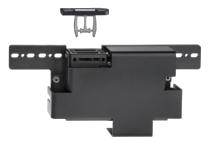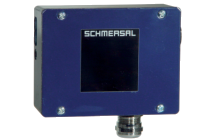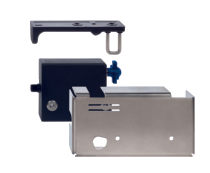Solenoid interlock

EX-AZM 170
- Explosion protection for ATEX Zones 2 and 22
- Thermoplastic enclosure
- 90 mm x 84 mm x 30 mm
- Interlock with protection against incorrect locking.
- High holding force
- Manual release
- 1 Cable entry M 20 x 1.5

EX-AZM 161
- Ex-Zone 22
- Thermoplastic enclosure
- 130 mm x 114 mm x 30 mm
- Clamping force 2000N
- 6 Contacts
- Manual release
- Interlock with protection against incorrect locking.
- cable entries 4 M 16 x 1.5

EX-AZM 415
- Ex-Zone 22
- Metal enclosure
- 130 mm x 100 mm x 46,5 mm
- Clamping force 3500N
- 2 switches in one enclosure
- Adjustable ball latch to 400 N
- Interlock with protection against incorrect locking.
- Problem-free opening of stressed doors by means of bell-crank system
- 2 cable entries M 20 x 1.5

EX-AZM 300
- Explosion protection for ATEX Zones 2 and 22
- RFID-technology for needs-based protection against tampering
- Thermoplastic enclosure
- Suitable for mounting to profile systems
- 3 different directions of actuation
- Suitable for hinged and sliding guards
- Series-wiring
Application:
The solenoid interlocks of the AZM series have been designed to prevent, in conjunction with the control part of a machine, e.g. fail-safe delay timers or fail-safe standstill monitors, sliding, hinged and removable safety guards such as fences, flaps or doors, from being opened before hazardous conditions (e.g. run-on movements) have been eliminated.
These solenoid interlocks are also used for cases in which the opening of a guarding device represents a non-permissible intrusion in a production process.
Design and mode of operation:
On the AZM range solenoid interlocks, the switching element with interlock is not physically connected to the actuator but functionally brought together or separated on switching. When the safety guard is opened in the unlocked condition, the actuator is separated from the base unit. During this process, the NC contacts are positively opened and the NO contacts closed.
Interlocking is carried out by means of a blocking bolt / latching bolt. This latching bolt blocks the actuator so that it cannot be withdrawn from the interlock. The machine control is only enabled when the actuator has been inserted into the interlock and the latching bolt is in blocking position. This is ensured by the contact monitoring of the latching bolt.
There are two modes of interlocking. The "Power to unlock" principle is where the locking bolt is held into position with a spring. When the de-interlocking coil is energised, the interlock is removed and the NC contacts opened. The protection equipment can be opened. For "Power to lock"1) the mode of operation is reversed.
The solenoid interlocks EX-AZM 161, 170 and 415 are fitted with protection against incorrect locking. Depending on the type of unit, an individual coding of the actuator are possible.
The solenoid interlocks can be fitted in any desired mounting position. Protection class of the solenoid interlocks is IP 54, IP 65 or IP 67.
1) In accordance with the policy of the German Technical Assessors, these interlock may only be used after a thorough evaluation of the accident risk, since the guarding device can immediately be opened on failure of the electrical power supply.
The solenoid interlocks of the AZM series have been designed to prevent, in conjunction with the control part of a machine, e.g. fail-safe delay timers or fail-safe standstill monitors, sliding, hinged and removable safety guards such as fences, flaps or doors, from being opened before hazardous conditions (e.g. run-on movements) have been eliminated.
These solenoid interlocks are also used for cases in which the opening of a guarding device represents a non-permissible intrusion in a production process.
Design and mode of operation:
On the AZM range solenoid interlocks, the switching element with interlock is not physically connected to the actuator but functionally brought together or separated on switching. When the safety guard is opened in the unlocked condition, the actuator is separated from the base unit. During this process, the NC contacts are positively opened and the NO contacts closed.
Interlocking is carried out by means of a blocking bolt / latching bolt. This latching bolt blocks the actuator so that it cannot be withdrawn from the interlock. The machine control is only enabled when the actuator has been inserted into the interlock and the latching bolt is in blocking position. This is ensured by the contact monitoring of the latching bolt.
There are two modes of interlocking. The "Power to unlock" principle is where the locking bolt is held into position with a spring. When the de-interlocking coil is energised, the interlock is removed and the NC contacts opened. The protection equipment can be opened. For "Power to lock"1) the mode of operation is reversed.
The solenoid interlocks EX-AZM 161, 170 and 415 are fitted with protection against incorrect locking. Depending on the type of unit, an individual coding of the actuator are possible.
The solenoid interlocks can be fitted in any desired mounting position. Protection class of the solenoid interlocks is IP 54, IP 65 or IP 67.
1) In accordance with the policy of the German Technical Assessors, these interlock may only be used after a thorough evaluation of the accident risk, since the guarding device can immediately be opened on failure of the electrical power supply.
.png?id=bb44e9061d048e5250879d3fc4285be0)